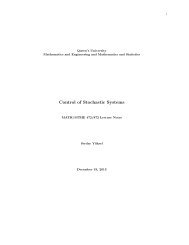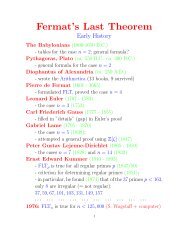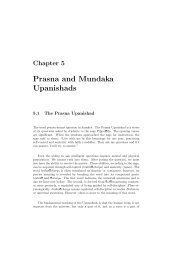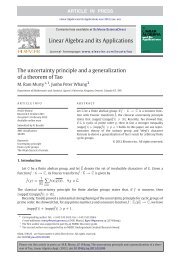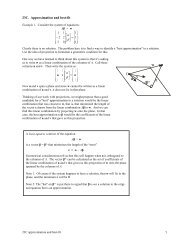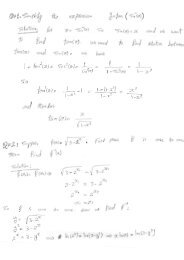Omar Khalil - Queen's University
Omar Khalil - Queen's University
Omar Khalil - Queen's University
You also want an ePaper? Increase the reach of your titles
YUMPU automatically turns print PDFs into web optimized ePapers that Google loves.
State-Dependent Criteria for Convergence of<br />
Markov Chains<br />
<strong>Omar</strong> khalil<br />
April 18, 2011<br />
1
Contents<br />
1 Introduction 3<br />
2 Background 3<br />
3 Summary of Results 6<br />
4 Critique and Concluding remarks 8<br />
5 References 11<br />
2
1 Introduction<br />
The problem of establishing recurrence and ergodicity of Markov chains is a fundamental<br />
issue in probability theory as well as in the numerous techniques where stochastic stability<br />
of Markov chains plays an important role such as dynamic programming and Markov Chain<br />
Monte Carlo. One of the main techniques of determining whether a Markov chain is stable or<br />
not is the standard Foster-Lyapunov approach which requires that the one-step mean drift of<br />
the chain be negative outside of some appropriately finite set. Although this technique has<br />
proved powerful in analysing many models, as the models get more and more complex analy-<br />
sis of the one-step drift often proves somewhat difficult. Malyˇshev and Men’ˇsikov developed<br />
a refinement of this approach for countable state space chains in [5] allowing the drift to be<br />
negative after a number of steps depending on the initial state.<br />
The goal of this project is to summarize and discuss an important paper [1] by Sean P.<br />
Meyne and R. L. Tweedie which shows that these countable state space results are special<br />
cases of a wider class of chains. The paper also develops a random step approach giving<br />
similar conclusions as well as state dependent drift conditions sufficient to establish geometric<br />
ergodicity of the chain; i.e, the n-step transition probabilities converge to their limits suffi-<br />
ciently geometrically fast.<br />
Although we will attempt to introduce the necessary mathematical concepts as we go by,<br />
a general background in probability theory and the theory of Markov chains is assumed and<br />
one may consult a text such as [9] which covers all the necessary material.<br />
2 Background<br />
Throughout this project we will be working with an underlying measure space (X, F), and a<br />
time homogeneous Markov chain Φ = {Φn, n ∈ Z+}. The transition probabilities of the chain<br />
3
are described by a transition function<br />
with iterates<br />
P : X × F → [0, 1]<br />
(x, A) ↦→ P (x, A)<br />
P n (x, A) = Px(Φn ∈ A), n ∈ Z+, x ∈ X, A ∈ F<br />
We say Φ is ϕ-irreducible if there exists a finite measure ϕ such that for all x ∈ X,<br />
ϕ(A) > 0 ⇒ �<br />
P n (x, A) > 0<br />
n<br />
We will assume for the remainder of our discussions that Φ is ϕ-irreducible. Next we<br />
introduce some minimal definitions of stability concepts.<br />
For A ∈ F define<br />
τA � inf{k ≥ 1 : Φk ∈ A}<br />
The chain Φ is Harris recurrent if for all x ∈ X<br />
ϕ(A) > 0 ⇒ Px(τA < ∞) = 1<br />
A σ-finite measure π on F is called invariant if for all A ∈ F,<br />
�<br />
π(A) =<br />
P (x, A)π(dx)<br />
If Φ is Harris recurrent then a unique invariant measure π exists. If it is finite we say Φ is<br />
positive Harris recurrent. For an aperiodic chain the existence of such a finite π is equivalent<br />
to the condition that<br />
lim<br />
n→∞ ||P n (x, ·) − π|| = 0<br />
for all x ∈ X. We say the chain is geometrically ergodic if this convergence occurs geometri-<br />
cally quickly ; i.e, if there exists a function M and a ρ < 1 such that<br />
||P n (x, ·) − π|| ≤ M(x)ρ n<br />
4
for all x ∈ X and n ∈ Z+.<br />
We mentioned in the introduction that the classical Foster-Lyapunov criteria requires<br />
analysis of the one step mean drift. Some examples of such conditions are the existence of a<br />
suitably unbounded function V and a test set C such that<br />
�<br />
P (x, dy)V (y) ≤ V (x), ∀ x ∈ C c<br />
which along with some other conditions would be equivalent to Harris recurrence. Another<br />
example is Foster’s criterion which requires the existence of some function V ≥ 0 and some<br />
test set C such that<br />
�<br />
P (x, dy)V (y) ≤<br />
� V (x) − 1 if x ∈ C c ,<br />
b < ∞ if x ∈ C<br />
Our last example is a condition for geometric ergodicity for countable space aperiodic chains<br />
which is that there exists a V ≥ 1 and some λ < 1 along with a test set C such that<br />
�<br />
�<br />
λV (x)<br />
P (x, dy)V (y) ≤<br />
b < ∞<br />
if x ∈ Cc ,<br />
if x ∈ C<br />
We say a set C ∈ F is petite if there exists a non-trivial measure ν and a distribution a on<br />
Z+ such that for all x ∈ X and all A ∈ F we have that,<br />
�<br />
a(n)P n (x, A) ≥ ν(A)<br />
n<br />
These sets play the role taken by the test sets in the countable state space context. Last of<br />
our background definitions is what it means for a function V to be unbounded off petite sets<br />
which is that the level sets {V ≤ α} are petite for all α ∈ R.<br />
All of the criteria given above analyse the one step mean drift,<br />
�<br />
∆V (x) = P (x, dy)[V (y) − V (x)]<br />
which proves difficult sometimes, and one may consult [2], [3] or [4] for such situations. Meyn<br />
and Tweedie’s paper contributes by providing criteria which allow analysis of models by using<br />
drifts at times which are not only state dependent but which may in fact be random. We<br />
begin with the result for the fixed state dependent times.<br />
5
3 Summary of Results<br />
Theorem 1. Suppose that Φ is a ϕ-irreducible chain on X and let n(x) be a measurable<br />
function from X to Z+.<br />
(i) The chain is Harris recurrent if there exists a petite set C and a function V ≥ 0 un-<br />
bounded off petite sets such that<br />
�<br />
P n(x) (x, dy)V (y) ≤ V (x), ∀ x ∈ C c<br />
(ii) The chain is positive Harris recurrent if there exists a petite set C and a function V ≥ 0<br />
bounded on C as well as a positive constant b such that<br />
in which case<br />
�<br />
P n(x) (x, dy)V (y) ≤ V (x) − n(x) + bIC(x), ∀ x ∈ X<br />
Ex[τC] ≤ V (x) + b, ∀ x ∈ X<br />
(iii) The chain is geometrically ergodic if it is aperiodic and if there exists some petite set C,<br />
a function V ≥ 1 bounded on C and positive constants λ < 1 and b such that<br />
�<br />
P n(x) (x, dy)V (y) ≤ λ n(x) [V (x) + bIc(x)], ∀x ∈ X (1)<br />
When (1) holds there exist constants r > 1 and R < ∞ such that<br />
�<br />
where π denotes the invariant measure.<br />
n<br />
r n ||P n (x, ·) − π|| ≤ RV (x), ∀x ∈ X<br />
Next we state the main results for random state-dependent times. To analyse those the<br />
paper considers the chain whose next position when Φ0 = x is given by Φζx where ζx is a<br />
random variable with distribution ax on Z+. We define the transition probabilities for this<br />
randomly sampled chain by<br />
�<br />
Ka(x, A) � Px(Φζx ∈ A) = ax(n)P n (x, A)<br />
6<br />
n
We will also define for non-negative functions V the function W given by<br />
W (x) = Ex<br />
�<br />
ζx−1 �<br />
k=0<br />
V (Φk)<br />
We will be referring to two conditions, the first is that<br />
and the second is that<br />
�<br />
W (x) < ∞, ∀ x ∈ X (2)<br />
�<br />
ax(i) ≤ Bxax(k), ∀ k ∈ Z+ (3)<br />
i>k<br />
Examples of distributions satisfying (3) is if ζx is geometric or uniform on {0, 1, . . . , M} for<br />
some M. However this condition does not hold if ζx is degenerate at n(x) which is the<br />
situation in Theorem 1. We will now state the random time results.<br />
Theorem 2. Suppose that Φ is a ϕ-irreducible chain on X and let ζx be a random variable<br />
on Z+, for each x independent of the chain.<br />
(i) The chain is Harris recurrent if there exists a petite set C and a function V ≥ 0 un-<br />
bounded off petite sets such that<br />
�<br />
Ka(x, dy)(x, dy)V (y) ≤ V (x), ∀ x ∈ C c<br />
(ii) The chain is positive Harris recurrent if there exists a petite set C and a function V ≥ 0<br />
bounded on C as well as a positive constant b such that<br />
provided (2) holds; in which case,<br />
�<br />
Ka(x, dy)V (y) ≤ V (x) − 1 + bIC(x), ∀ x ∈ X (4)<br />
Ex[τC] ≤ W (x) + b, ∀ x ∈ X<br />
If ax satisfies (3) and (4) holds then (2) holds.<br />
7
(iii) The chain is geometrically ergodic if it is aperiodic and if there exists some petite set C,<br />
a function V ≥ 1 bounded on C and positive constants λ < 1 and b such that<br />
�<br />
Ka(x, dy)(x, dy)V (y) ≤ λV (x) + bIc(x), ∀x ∈ X<br />
provided ax satisfies (3) with Bx ≤ B < ∞ independent of x. In which case there exist<br />
constants r > 1 and R < ∞ such that<br />
�<br />
n<br />
r n ||P n (x, ·) − π||V ≤ RV (x), ∀x ∈ X<br />
where π denotes the invariant measure and the V -norm || · ||V is defined for any signed<br />
measure µ by<br />
�<br />
||µ||V � sup<br />
|g|≤V<br />
4 Critique and Concluding remarks<br />
µ(dy)g(y)<br />
This paper by Meyne and Tweedie introduces several contributions to the existing literature.<br />
The first is that it generalizes the results of Malyˇshev and Men’ˇsikov in [5] to the wider<br />
context of ϕ-irreducible chains as well as providing sample path proofs which fit nicely with<br />
the nature of such chains. The second is the development of the random step approach which<br />
we have seen earlier in the summary of the results. Finally the paper contributes by finding<br />
state dependent sufficient conditions for the recurrence and ergodicty of Markov chains that<br />
provides an alternative to analysing the one step mean drift. This is particularly useful when<br />
drift functions which depend on the whole history of the chain are used such as in [2],since<br />
in those cases analysis of the one step mean drift becomes complicated.<br />
A natural question however which arises upon reading this paper is what about the random<br />
times which don’t meet the geometric growth condition (3) ? It seems plausible to assume<br />
that both theorems 1 and 2 are special cases of a more general result covering random times<br />
which don’t necessarily meet that condition and in fact later extensions such as [6] and [7]<br />
, show that it is possible to let go of that condition and analyse random times whose tail is<br />
8
not necessarily geometric in nature. Meyne displays however that a hopeful jump such as<br />
replacing the condition in theorem 1 (ii) with<br />
instead of<br />
�<br />
�<br />
P n(x) (x, dy)V (y) ≤ V (x) − 1 + bIC(x)<br />
P n(x) (x, dy)V (y) ≤ V (x) − n(x) + bIC(x)<br />
is not possible by providing a counter example. Hence the correct generalization is not nec-<br />
essarily obvious.<br />
An element of the paper which we did not have a chance to cover in the summary due<br />
to space constraints but would still like to give a general idea about are the applications,<br />
both mentioned in the paper itself and the ones which depend on state dependent criteria in<br />
general. It is useful to note that before this paper the applications which relied only on the<br />
countable state results developed in [5] have typically been on orthants where the negative<br />
drift could be established easily in the interior of the space and drift with a fixed number of<br />
steps established on the boundary of the space. However even in those cases Meyn shows that<br />
the state dependent criteria provided in this paper could make things simpler. Nonetheless<br />
the paper exhibits both discrete time and continuous time applications where analysis using<br />
the fixed state criteria would be difficult. The applications included an antibody model, a<br />
non-linear autoregressive model as well as complex queuing models.<br />
Concerning applications in general, the state dependent criteria technique is the basis of<br />
the fluid model approach to stability in stochastic networks and other general models. Fur-<br />
thermore, discussions in [7] show that the state dependent random sampling technique has<br />
applications in networked control, where there is only intermittent access to either sensor<br />
information or control and depending on the availability of resources the timing is in general<br />
random. Hence the results of the paper prove applicable in numerous settings beyond pure<br />
probability theory.<br />
In conclusion this paper not only contributes important sufficiency results but also introduces<br />
9
useful techniques for analysing stochastic stability of Markov chains in general. The state de-<br />
pendent random sampling criteria proves to have many practical applications. Natural steps<br />
beyond this paper include generalizing theorems 1 and 2 to results where both these theorems<br />
are special cases and which do not necessarily include the geometric growth condition. Fur-<br />
thermore one may want to consider analysing the rates of convergence of the Markov chains<br />
which is of particular importance in real time control systems.<br />
10
5 References<br />
[1] Meyn, S.P. and Tweedie, R. (1994) State-dependent criteria for convergence of Markov<br />
chains Ann. Appl. Probab. 4 149-168.<br />
[2] Meyn, S. P. and Guo, L. (1992). Stability, convergence, and performance of an adaptive<br />
control algorithm applied to a randomly varying system. IEEE Trans. Automat. Control<br />
AC-37 535-540.<br />
[3] Chen, R and Tsay, R.S. (1991). On the ergodicity of TAR(1) processes. Ann. Appl.<br />
Probab. 1 613-634.<br />
[4] Tjøsthem, D. (1990). Non–linear time series and Markov chains. Adv. in Appl. Probab.<br />
22 587-611.<br />
[5] Malyˇshev, V. A. and Men’ˇsikov, M. V. (1982). Ergodicity, continuity and analyticity of<br />
countable Markov chains. Trans. Moscow Math. Soc. 1 1-48.<br />
[6] Yüksel, S. (2009). A Random Time Stochastic Drift Result and Application to Stochastic<br />
Stabilization Over Noisy Channels. Allerton Conference, Illinois, USA.<br />
[7] Yüksel, S. and Meyn. S. P. (2010). Random-Time, State-Dependent Stochastic Drift for<br />
Markov Chains and Application to Stochastic Stabilization Over Erasure Channels. IEEE<br />
Trans. Automat. Control.<br />
[8] Yüksel, Serdar. (2011). Math 472/872 Course Lecture Notes. Queen’s <strong>University</strong>.<br />
[9] It ô, Kiyosi. Introduction to Probability Theory. Cambridge <strong>University</strong> Press, 1986.<br />
11



